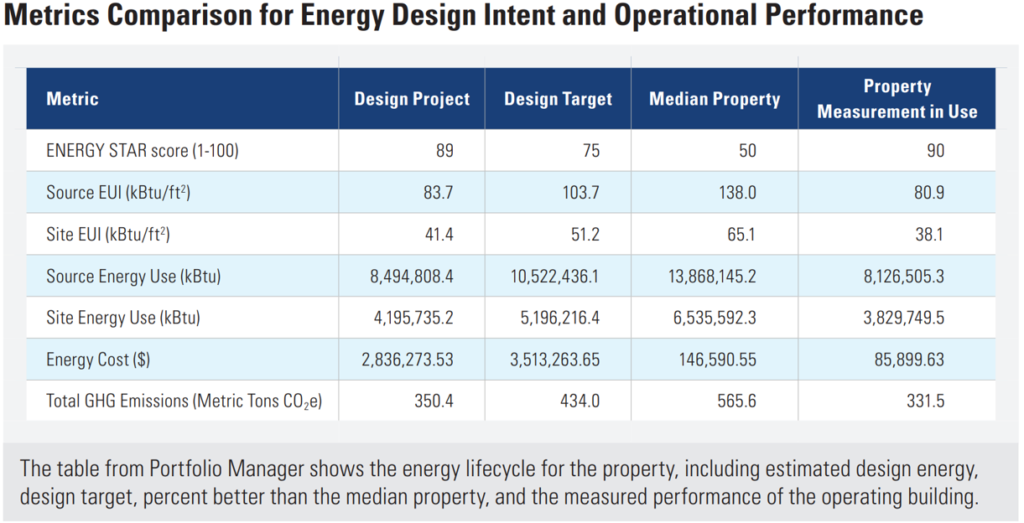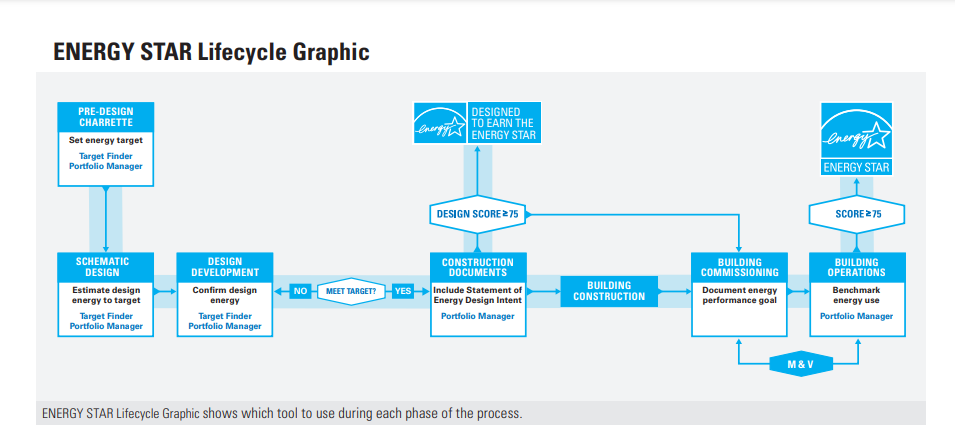Breadcrumb Navigation
- Lighting Insights
- ENERGY STAR®: New Tools for Energy Modeling
ENERGY STAR®: New Tools for Energy Modeling
It’s a challenging time to bring a new building online. ENERGY STAR benchmarking tools can help relieve some uncertainty.

The farther backward you can look, the farther forward you can see.—Winston Churchill
A recent article on Facilitiesnet.com noted a trend among building owners and design teams to specify energy use targets for new commercial construction. Armed with historical benchmarking data and proven strategies for optimizing energy use, designers and builders are seeking to build energy conservation into their new projects from the ground up.
There are several market pressures driving this trend. Municipalities, counties and states are passing ever-stricter energy conservation mandates and building codes, even as climate models predict that each passing year will bring more volatile weather patterns and extreme weather events. COVID has significantly, and perhaps permanently, changed how commercial office space will be used. The cost of energy is expected to continue to climb. Finally, energy use disclosure is becoming a common requirement in commercial real estate transactions and is increasingly mandated by law.

Not surprisingly, building owners and designers are looking for tools to help them navigate this landscape. In a recent survey, 97% of respondents (energy analysts, architects, academics and mechanical engineers) said they recommend early design analyses to inform building strategies, especially for energy use. Yet only 60% reported that they regularly do such analyses, noting that the modeling typically required can be complicated, expensive and difficult to use.

That’s where the ENERGY STAR® tools can help. When the Environmental Protection Agency’s (EPA) ENERGY STAR® program introduced its popular online Portfolio Manager® almost 10 years ago, the buzz was about benchmarking existing buildings – that is, measuring and comparing a building’s energy use to similar buildings, past consumption or a reference performance level. Its companion tool, Target Finder™, was designed to enable fast “what-if” scenarios comparing various energy strategies to the national median. Both tools calculate an ENERGY STAR® score using a 100-point scale that has become the industry standard for rating a facility’s energy performance. Now these tools are helping building owners and designers target energy goals during the initial design process for new construction, and to evaluate and refine strategies throughout the design and build-out.
Energy Modeling Made Easier
Target Finder has always made it quick and easy to set whole-building targets, allowing building owners and architectural and engineering (A/E) firms to quickly evaluate alternative energy strategies and generate a projected ENERGY STAR® score on a 100-point scale. Target Finder can be used to assess annual energy usage levels (and limits) required to meet targets, and to derive corresponding efficiency metrics, projected energy costs and greenhouse gas emissions.

Portfolio Manager goes deeper, comparing a building’s proposed energy design with the actual real-life energy performance of similar existing buildings. The available data is now substantial: today nearly 25% of U.S. commercial buildings are actively benchmarking in Portfolio Manager, making it the industry-leading benchmarking tool. In 2020, Portfolio Manager tracked the energy use of more than 270,000 commercial properties across the nation, ranging from hospitals, schools and professional offices to industrial facilities, warehouses and manufacturing plants.
This data is also easy to access, save and share across users in a secure online environment. Metrics can be sorted by property type, size, function and factors such as operating hours, number of occupants and number of computers. The data calculations are already adjusted based on local climate and other geographical factors, allowing high accuracy for projecting estimated site and source energy use intensity (EUI), total annual energy use, costs and greenhouse gas emissions. Owners and designers can also create custom reports to project energy use over the life of the building. Portfolio Manager further categorizes the ENERGY STAR® score across 15 property types, making the score a strong predictor of a building’s eligibility for “Designed to Earn the ENERGY STAR®” recognition.

Use EPA’s Target Finder Calculator
Target Finder is the EPA’s quick-and-easy online calculator to help architects, engineers, and property owners and managers assess the energy performance of commercial building designs and existing buildings. There’s no login required, which makes Target Finder useful for fast calculations and “what-if” scenarios. There are two basic ways to use Target Finder:
- See what annual energy usage you need to achieve to meet a target: If you enter basic information about your business activity and set a target, you can see what this target means in terms of energy use, cost and greenhouse gas emissions.
- Evaluate estimated energy use: If you already know the estimated energy use for an existing design or retrofit project, you can calculate the corresponding efficiency metrics, costs and emissions.
How Target Finder Works
Like Portfolio Manager, Target Finder accounts for building and operating characteristics such as operating hours and number of computer workstations, as well as 30-year weather data for your project site. It then compares this data to the actual energy consumption of real buildings, as collected by nationally representative surveys, such as DoE’s Commercial Buildings Energy Consumption Survey (CBECS).

The data from these surveys are built into Target Finder, meaning that, with a couple mouse clicks, you can assess your designs against the best-available data sample in the nation, plus have it normalized for size, operating characteristics and weather.
Comparing Your Apples To Their Apples

This sample Portfolio Manager table shows the energy lifecycle of a sample commercial property, including the estimated design energy, design target, percent above the national median and the actual measured performance of the operating building.
The ENERGY STAR® score of 89 for the Design Project exceeds the Design Target of 75 and Median Property of 50. This property’s operating score is 90, outperforming the design target estimate. Sharing this kind of information with design teams and O&M staff can help with critical decisions when designing and operating buildings to achieve performance goals.
Which Tool to Use?
Target Finder allows you to perform all the calculations you can perform in Portfolio Manager without logging in. But if you’re willing to create an ENERGY STAR® account, Portfolio Manager further allows you to:
- Securely save your information
- Share data with colleagues, clients or vendors
- Track changes over time
- Compare design estimates with measured performance once a building is in use
- Compare a new design project with existing buildings
- Apply for “Designed to Earn the ENERGY STAR®” recognition and ENERGY STAR® certification
Smarter Energy Decisions. Greater Energy Savings.
The data generated by these two ENERGY STAR® tools can be shared with both building owners and design teams to inform critical decisions that will impact a building’s energy performance goal.
ENERGY STAR® Lifecycle Graphic

Want to Learn More?
In addition to the links above, you can find more ENERGY STAR resources and information here. And you can download ENERGY STAR Design Guidance and a related checklist that shows you how to set an energy target, evaluate energy strategies, document energy intent and earn program recognition.
The Cree Lighting website’s Resources section also has several useful calculators and configurators that you can use in tandem with the ENERGY STAR tools to whiteboard various lighting strategies for your new project and ensure your lighting strategy is not only optimized for energy savings, but delivers the best possible illumination to meet your overall lighting design goals.
Additionally, you can shop the range of Cree Lighting bulbs that are Energy Star certified, such as the A19 Pro Series, A21 Pro Series, and R20 Pro Series, as well as a myriad of other options.
